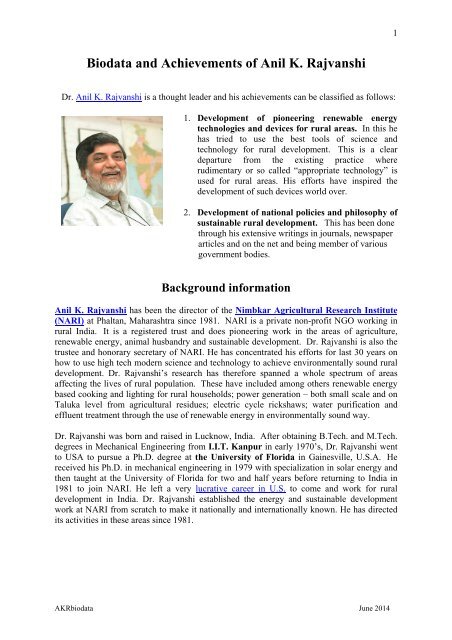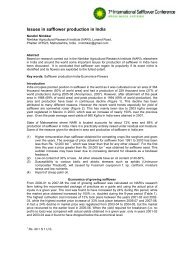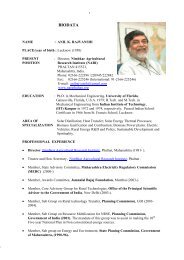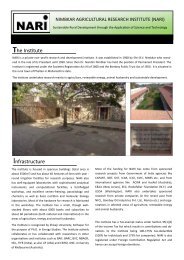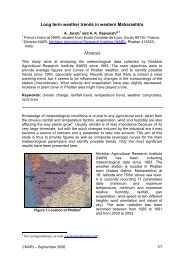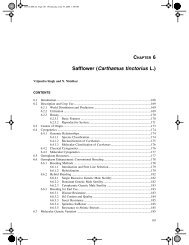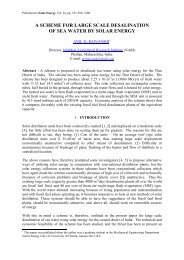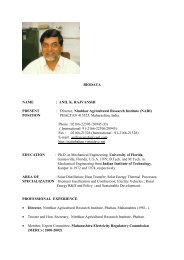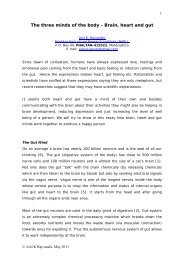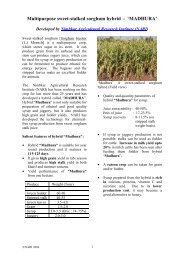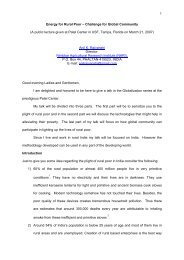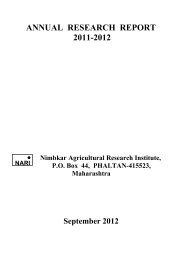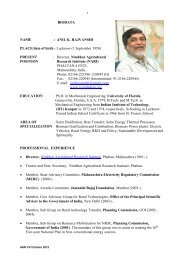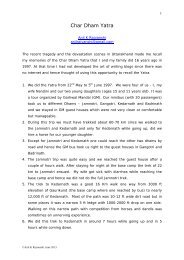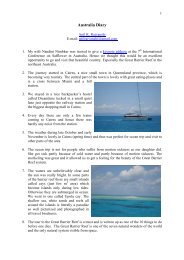You also want an ePaper? Increase the reach of your titles
YUMPU automatically turns print PDFs into web optimized ePapers that Google loves.
1Biodata and Achievements of <strong>Anil</strong> K. <strong>Rajvanshi</strong>Dr. <strong>Anil</strong> K. <strong>Rajvanshi</strong> is a thought leader and his achievements can be classified as follows:1. Development of pioneering renewable energytechnologies and devices for rural areas. In this hehas tried to use the best tools of science andtechnology for rural development. This is a cleardeparture from the existing practice whererudimentary or so called “appropriate technology” isused for rural areas. His efforts have inspired thedevelopment of such devices world over.2. Development of national policies and philosophy ofsustainable rural development. This has been donethrough his extensive writings in journals, newspaperarticles and on the net and being member of variousgovernment bodies.Background information<strong>Anil</strong> K. <strong>Rajvanshi</strong> has been the director of the Nimbkar Agricultural Research Institute(<strong>NARI</strong>) at Phaltan, Maharashtra since 1981. <strong>NARI</strong> is a private non-profit NGO working inrural India. It is a registered trust and does pioneering work in the areas of agriculture,renewable energy, animal husbandry and sustainable development. Dr. <strong>Rajvanshi</strong> is also thetrustee and honorary secretary of <strong>NARI</strong>. He has concentrated his efforts for last 30 years onhow to use high tech modern science and technology to achieve environmentally sound ruraldevelopment. Dr. <strong>Rajvanshi</strong>’s research has therefore spanned a whole spectrum of areasaffecting the lives of rural population. These have included among others renewable energybased cooking and lighting for rural households; power generation – both small scale and onTaluka level from agricultural residues; electric cycle rickshaws; water purification andeffluent treatment through the use of renewable energy in environmentally sound way.Dr. <strong>Rajvanshi</strong> was born and raised in Lucknow, India. After obtaining B.Tech. and M.Tech.degrees in Mechanical Engineering from I.I.T. Kanpur in early 1970’s, Dr. <strong>Rajvanshi</strong> wentto USA to pursue a Ph.D. degree at the University of Florida in Gainesville, U.S.A. Hereceived his Ph.D. in mechanical engineering in 1979 with specialization in solar energy andthen taught at the University of Florida for two and half years before returning to India in1981 to join <strong>NARI</strong>. He left a very lucrative career in U.S. to come and work for ruraldevelopment in India. Dr. <strong>Rajvanshi</strong> established the energy and sustainable developmentwork at <strong>NARI</strong> from scratch to make it nationally and internationally known. He has directedits activities in these areas since 1981.AKRbiodata June 2014
2Household cooking and lightingTechnology DevelopmentWith the help of his colleagues, Dr. <strong>Rajvanshi</strong> has carried out research in varied subject areas,which were selected based on perceived needs of local rural population in and aroundPhaltan.For example, during his early stay in 1980s at Phaltan (a rural town) the electricity situationwas not very good resulting in frequent blackouts. This made him start work on developingan improved and very efficient liquid fuel lantern. The designing of the lantern required verysophisticated tools of heat and mass transfer, combustion and fluid dynamics. This lanternchristened “NOORIE” is a multifuel one and runs on kerosene, diesel and low concentrationethanol. According to knowledgeable experts in the area of liquid fuel lighting, developmentof NOORIE lantern was the first major advancement since early 1920s in lantern technology.It is much more efficient than the existing available designs and is much easier to light.Besides, it also doubles as a small cooking stove. There is a good demand for Noorielanterns both internally and for exports.Recently the concept of Noorie lantern has been expanded into kerosene Lanstove. Thisdevice simultaneously provides excellent light and cooks a complete meal for a family offive. Lanstove is being extensively tested in rural huts around Phaltan. Working with ruralpoor during lanstove testing also showed that rural poor eat nutritionally very poor diet. Thisled Dr. <strong>Rajvanshi</strong> to develop a concept of rural restaurants which is being actively pursuedby various Government and International agencies as a viable way for improving the nutritionof rural poor.In developing kerosene lanterns, Dr. <strong>Rajvanshi</strong> became acutely aware of the need fordeveloping an alternative liquid fuel which should be renewable, environmentally sustainableand home-grown. Consequently, he and his team established the pioneering program forproduction of ethanol from sweet sorghum in middle 1980’s.Sweet sorghum is an excellent substitute to sugarcane for ethanol production. Besides it is amulti purpose crop and produces grain, sweet juice and excellent fodder simultaneously fromthe same piece of land. Per unit of water consumption it is also one of the most efficient sugarproducers. Dr. <strong>Rajvanshi</strong> and his group established in late 1980’s, probably one of thelargest multidisciplinary research programs in the world on sweet sorghum for ethanolproduction. It included extensive breeding for higher yielding varieties, fermentationstudies, solar distillation plant (a 50 l/day pilot plant running completely on solar energywas set up at <strong>NARI</strong> campus in 1987), and development of stoves and lanterns to work onlow concentration ethanol. These efforts resulted in making <strong>NARI</strong> the only Institute inIndia to be invited by European Economic Commission in 1993 to be a part of Europeannetwork in Sweet Sorghum Research and Development.As a result, <strong>NARI</strong>’s sweet sorghum hybrids have been tested and sown in about ninecountries viz. Mexico, Zambia, Thailand, Pakistan, Zimbabwe, Portugal, Mauritius, Franceand Italy. Besides the production of ethanol, Dr. <strong>Rajvanshi</strong> and his team also embarked uponthe development of complete technology for producing jaggery and syrup from sweetsorghum. The MADHURA sweet sorghum syrup has been successfully test-marketed. TillAKRbiodata June 2014
3today about 4 tons of it has been sold. It is a natural plant product and has been found to bean excellent source of calcium. Presently it is being used as a base for Ayurvedic medicinesand as a natural sweetener in many food products.Because of the efforts of Dr. <strong>Rajvanshi</strong> and his team members Government of India hasrecently set up a National project on sweet sorghum where about a dozen agriculturaluniversities are involved in research and development. Also large numbers of privatecorporations have become interested in the use of sweet sorghum for ethanol production.This shows the foresight of <strong>NARI</strong>’s effort in early 1980s. The whole idea behind sweetsorghum development was to give farmers value-addition so that they could earn extraremuneration. Besides, sweet sorghum can provide clean and environmentally sound ethanolfuel to the rural areas.Dr. <strong>Rajvanshi</strong>’s pioneering work on lighting and cooking technologies using ethanol ashousehold fuel has been replicated all over the world. Also his seminal paper on cookingand lighting strategy (published in 2003 in Current Science Journal) set the tone for researchworldwide in high tech rural cooking technology such as the use of electricity fromthermoelectric elements for running a small fan; small scale biogas plants for cooking; anduse of alternative fuels like vegetable oils and alcohol for cooking. A direct outcome of thispaper was the development of Philip’s stove running on fan powered by thermoelectricelement. Similar inventions are being developed for rural biomass stoves.This paper on cooking and lighting strategy incidentally was also the first paper anywherewhich showed how nanotechnology can be used for rural development. The paper, whichwas widely covered in newspapers and mass media, prominently figured in a white paper onNanotechnology for Rural Poor by Meridian Institute in Washington D.C. and later on led tothe efforts by Government of India (through DST) to set up a small national program onNanotechnology for Rural Development.For rural household Dr. <strong>Rajvanshi</strong> and his team have therefore pioneered the development ofethanol lanterns and stoves, and his recent invention has been to combine the lantern andstove. This device christened lanstove produces very bright light and simultaneously cooks acomplete meal for a family of four or five. Besides it also produces clean drinking water.Thus for the first time in the world an innovative design has been developed which provideslight, cooking and clean drinking water for rural areas using low grade ethanol-a locallyavailable and environmentally sound fuel. This innovation was given the Globe ForumAward in 2009 by Crown princess Victoria in Stockholm, Sweden. This invention has alsoelicited worldwide interest on the use of ethanol fuel for cooking and lighting in rural areas.The work on sweet sorghum ethanol production also led to the development of technology forcleaning the distillery waste. In rural areas of Maharashtra there is a widespread network ofsugar factories. These factories produce molasses as a byproduct, which is used for producingethanol in distilleries. The effluent produced in this process is dark-colored and has anobnoxious smell. It also has a very high chemical oxygen demand (COD). Most of the timesthis effluent is discharged without any treatment and pollutes surrounding water bodies. Thisaffects the health of the people and animals living in these areas. Even if this effluent istreated for producing methane, it is only partially purified and its black color still remains.Dr. <strong>Rajvanshi</strong> and his group have developed and patented a method to clean this effluentcompletely with the help of a photo catalyst and solar energy. Thus the black color isremoved and the COD is drastically reduced. This was probably one of the first suchAKRbiodata June 2014
4innovations regarding the solar detoxification of distillery effluent. This method has beensuccessfully tested in a pilot plant set up at <strong>NARI</strong> campus to treat 100 l effluent per day.Many distilleries have expressed interest in this technology.Rural power generationAnother example of need-based research was the development of loose biomass gasifier. InPhaltan taluka there are two sugar factories with a lot of farmers growing sugarcane. Aftercutting the sugarcane, farmers burn the dried leaves on ground. There are estimates that Indiaproduces about 800-1200 million tons of agriculture residues every year and most of them areburned in the fields. This is not only a loss of a valuable natural resource, but also leads totremendous air pollution and production of greenhouse gases. Recently it has been shown thatburning of agricultural residues in the subcontinent is the cause of the huge brown cloud overthe area.Dr. <strong>Rajvanshi</strong> has through his writings and speeches brought out the fact that agriculturalresidues can produce almost half of the electric power of India. Besides they will also giveextra income to the farmers. Recently this strategy is being promoted by the Govt. of India. Inorder to produce power on small scale from agricultural residues, Dr. <strong>Rajvanshi</strong> and his teamdeveloped and setup at <strong>NARI</strong> campus a 500 KW th loose sugarcane leaves gasifier for whichthey have received a patent. The gasifier which is totally automatic and is a PLC-basedsystem can be very useful for providing heat for rural businesses. This gasifier set up in 1997was the first such invention anywhere in the world which produced gas from loose leafybiomass material for heating purposes and also produced biochar-an excellent soilconditioner, as a byproduct.The development of a gasifier running on loose agricultural residues led Dr. <strong>Rajvanshi</strong> todevelop a concept of providing electric power to a taluka (equivalent to a county inU.S.A.) from the agricultural residues produced within its geographical boundary. He is theprincipal author of national policy on Energy Self-Sufficient Talukas. This policy wasimplemented by the Ministry of Non-conventional Energy Sources, Government of India. Asa part of this policy all the talukas of the country were surveyed and a biomass map of Indiawas produced for power generation. Also as a part of this policy Government of India,through Indian Renewable Energy Development Agency (IREDA), has provided soft loans tomore than 100 biomass-based power stations (each of 6-10 MW capacity) in the country.This is a prime example of Dr. <strong>Rajvanshi</strong>’s efforts in creating a national program forproducing environmentally sound power from renewable biomass source. He has alsoextended this concept to a village-level micro-utility.Rural transportAs a part of providing sustainable transport system in rural areas where distances are small,Dr. <strong>Rajvanshi</strong> has concentrated his efforts since 1995 on improving the cycle rickshaw sothat the hardships being borne by the rickshaw pullers are reduced.The existing cycle rickshaw has been totally reengineered for the comfort of passengers andrickshaw puller. He and his team have therefore developed three types of rickshaws. In theimproved cycle rickshaw (IMPRA), the length of chain has been reduced; it has back-wheelbraking, three-speed gears and it is lightweight. All these improvements enable the rickshawpuller to take two passengers on a 6-10% slope quite effortlessly without alighting from hisAKRbiodata June 2014
5seat. In addition, by attaching a small battery-driven motor to IMPRA, a motor-assistedpedal rickshaw (MAPRA) has been developed. This enables the rickshaw puller to take twopassengers on a 10% slope at a speed of 10-15 km/hr without getting down from his seat.Recently about two dozen IMPRAs and MAPRAs have been exported to Europe, Canadaand US.<strong>NARI</strong>’s pioneering program on improved and electric rickshaws which started in 1995 hasinspired world-wide interest and effort in the area of human-powered transport. This isattested to by the fact that material from <strong>NARI</strong>’s website on rickshaws is copied by a largenumber of rickshaw and cycle enthusiasts on to their websites and discussed on various webgroups. Besides this a large number of requests for cycle rickshaw supply regularly comefrom European and American cities.Finally, Dr. <strong>Rajvanshi</strong> and his team have developed ELECSHA-an electric rickshaw, whichruns at 30-35 km/hr and can travel 60 km with two passengers in one battery charge. Notonly will these improved rickshaws prove to be a good alternative to the cycle rickshaws inuse presently, but also to the 3 and 6-seater auto rickshaws which cause tremendous noise andair pollution in various cities of India.Dr. <strong>Rajvanshi</strong> is also trying to set up rickshaw pullers’ cooperative societies in different citiesso that the rickshaw pullers can get loans from the banks to buy the rickshaws. He believesthat electric cycle rickshaws can provide an environmentally sound rural and urban transportsystem for India. This work on rickshaws has been extensively covered both in print andmass media including BBC, Star News, Doordarshan etc.The work on motor-assisted rickshaw has also led to the development of a motor-assistedhand operated wheel chair for physically handicapped. The vehicle christened MANHARA(motor assisted <strong>NARI</strong> handicapped rickshaw) is really a great boon to disabled people as itincreases their mobility. Efforts are on to commercialize these vehicles. Recently acompletely automatic electric tricycle for handicapped persons has been designed andsuccessfully used by a few physically challenged persons.Other technologiesIn addition to these projects, Dr. <strong>Rajvanshi</strong> has also concentrated his attention on howfarmers can derive maximum benefit from crops such as safflower. He has developed thewhole plant approach such that all parts of plants are useful to humans and that the farmerscan earn extra income. Thus the safflower crop, besides producing seed for oil, will also beused to harvest its petals. He has been instrumental in popularizing safflower petal as herbaltea and has developed a solar powered battery-operated machine to collect petals fromspiny safflower plants. The batteries are charged by solar energy. The remuneration tofarmers is increased several fold due to these petals. He is also starting a program onsustainability at <strong>NARI</strong> whereby from the same piece of land food, fuel, feed and fertilizerproduction can be optimized.Dr. <strong>Rajvanshi</strong> and his team have also pioneered a technique to provide potable water torural areas with minimal heating. Thus by filtering the dirty water through four layers ofcotton sari and then heating to 55-60 0 Celsius all the coliforms are eliminated and the water isfit for drinking. Heating the water to sub boiling temperatures greatly reduces the energyAKRbiodata June 2014
6requirements of making water potable. A paper (published in Current Science) is on this siteand a syndicated story appeared in various news channels.All the technology development and dissemination of the knowledge has been greatlyfacilitated by the use of internet. Thus Dr. <strong>Rajvanshi</strong> has tried to use this modern tool forrural applications such as e-commerce and technology transfer. <strong>NARI</strong> was probably one ofthe few rural-based organizations in India to get e-mail connectivity in 1995! Since then<strong>NARI</strong> has used internet and social media extensively for spreading its message. <strong>NARI</strong>’swebsite has very high hit rates on Google and other search engines. Thus <strong>NARI</strong> has beenable to share its expertise and technology with the rest of the world. This has resulted inworldwide use of its technologies and has also attracted large number of interns from all overthe world who come for short term internship at <strong>NARI</strong>.Holistic and Sustainable DevelopmentBesides the technology work, Dr. <strong>Rajvanshi</strong> is also interested in the issues of spirituality. Hewrites occasional editorial articles on this subject in Times of India and has published abook entitled “Nature of Human Thought – Essays on Mind, Matter, Spirituality andTechnology”. His work on spirituality has focused mostly on the issues of interlinkingspirituality with technology and sustainability. In his own life he has shown that with the useof high technology like internet, renewable energy, modern communication network, andpracticing spirituality to curb the greed for resources, one can live a sustainable andemotionally satisfying life. On this issue of sustainable living he gives inspirational lecturesall over the world and has tried to inspire and guide young engineering and managementstudents from some of the prestigious Schools in India like IITs and IIMs.Dr. <strong>Rajvanshi</strong>’s writings on the issue of technology and spirituality have been widely read,are copied on various blogs and websites and occupy a very high position in Google searchengine. Recently he has been given a blog space as a master on Speaking Tree (Times ofIndia) website.His work on spirituality and holistic development has led him to set up a Center ofSustainable Development (CSD) at <strong>NARI</strong> campus. This training and research center willtry to bring corporate, NGOs and local people together for sustainable development of ruralareas. Dr. <strong>Rajvanshi</strong> believes that corporations can become very active players in ruraldevelopment once they are sensitized to the plight of rural poor. Besides, the exposure tocombination of spirituality and technology will allow then to curb their greed and participatewholeheartedly in corporate social responsibility (CSR) activities. He has written andlectured extensively on this subject of corporate/NGO partnership.HonorsIn 2001, Dr. <strong>Rajvanshi</strong> received the prestigious Jamnalal Bajaj Award for the use of scienceand technology in rural development from Dr. Manmohan Singh (presently the PrimeMinister of India). This is one of the most well known awards in India for rural developmentand in the past has been given to Nelson Mandela and Desmond Tutu (International AwardAKRbiodata June 2014
7Category). In 1998 Dr. <strong>Rajvanshi</strong> was inducted in the U.S.-based Solar Hall of Fame. He isthe second Indian to be so inducted. He and his team’s efforts have resulted in <strong>NARI</strong> gettingthe Federation of Indian Chambers of Commerce and Industries (FICCI) Platinum JubileeAnnual Award (2001-2002) for rural development at the hands of the then Prime MinisterShri. Atal Behari Vajpayee. In 2004 his work on MAPRAs was given the Energy GlobeAward (in the AIR category). In May 2009 he delivered the prestigious B.D. TilakMemorial Lecture at National Chemical Laboratory (NCL), Pune. His work on ethanollantern/stove was given the Globe Forum Award for sustainability research in Stockholm.He received this award from HRH Crown Princess Victoria in June 2009. In 2014 Dr.<strong>Rajvanshi</strong> was honored with the Distinguished Alumnus Award of University of Florida,USA.The Central Government and Government of Maharashtra has appointed Dr. <strong>Rajvanshi</strong> onmany prestigious committees. Therefore he is serving, or has served on central Governmentcommittees like Core group on rural technology in the Office of the Principal ScientificAdvisor to the Government of India, Advisory Board of Energy, Planning Commissionand Ministry of Non-conventional Energy Sources among others. At state level he has beennominated as member State Planning Commission (Energy and Environment AdvisoryCommittee) and advisory board of Maharashtra Electricity Regulatory Commission. Inthe past he has been advisor and consultant to International Foundation of Science (Sweden),Winrock International (USA), E & Co (USA) etc.Dr. <strong>Rajvanshi</strong>’s achievements have been widely covered in mass media both nationally andinternationally. Major stories on him have come in Harmony Magazine, India Today, Sakaland other publications. These stories and others are also available at this site. Similarly he hasbeen featured in NDTV, Doordarshan, AIR, SAM TV, among others.Lectures/PublicationsDr. <strong>Rajvanshi</strong> has lectured at many universities in U.S.A. and India. He regularly givesinspirational lectures to a large number of students of prestigious institutes like IITs, RegionalEngineering Colleges, various Institutes of Management etc. and has inspired them to take uprural development as a vocation (details are at this site).In July 2002 he was honored by the Department of Mechanical Engineering at University ofFlorida, Gainesville by inviting him to give the inaugural lecture of the Charles V and BerthaC Perill Lecture Series on Sustainable Development. In September 2003 he was invited bythe Principal Scientific Advisor to Government of India, Dr. R. Chidambaram to addressBARC scientists on rural development. In 2004 he gave a distinguished lecture in theCollege of Engineering at University of Florida on his work at <strong>NARI</strong>. He has also beeninvited to give lectures at MIT, Boston and to address the prestigious IDEAS competition. In2006 he was invited to give an Institute lecture at IIT Bombay and in March 2007 hedelivered a public lecture at the Patel Center of Sustainable Solutions in USF, Tampa.Also in 2007 Cornell University made a half an hour video e-clips on his views onsustainable rural development, simple living and R&D for rural areas. In November 2007 hewas invited by the UNDP and the Chinese Government to advise them on the rural energyprogram. Out of the five experts from all over the world he was the only Indian invited. In2012 he was invited to give a keynote address at the Silver Jubilee celebration conference ofAKRbiodata June 2014
8Indian National Academy of Engineering. Recently he gave an invited lecture at StanfordUniversity – Reliance Industries workshop in Mumbai. The video of the lecture is here.He has more than 160 publications, some of them in prestigious national and internationaljournals, seven patents, three chapters in books and two books (one on spirituality andother on his experiences as a student in 1970s in US) to his credit. Recently he has written ahuman interest history of renewable energy work at <strong>NARI</strong>.He writes regular blog on spirituality in Speaking Tree website of Times of India. He haschaired many sessions at national and international conferences and has given keynoteaddresses in many of them. His work has been carried extensively both in print andelectronic media.Dr. <strong>Rajvanshi</strong>'s biodata in pdf.Dr. <strong>Rajvanshi</strong>'s short biodata©<strong>Anil</strong> K <strong>Rajvanshi</strong>, June 2014.HOMEAKRbiodata June 2014


